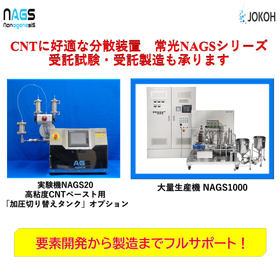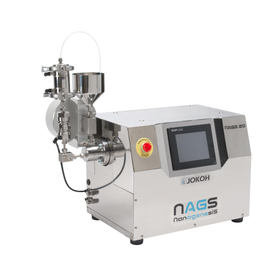Mechanism of the ultra-high pressure homogenizer
Make it into a slurry and perform dispersion.
A "slurry" mixed with powder, solvent, and a dispersant to prevent re-agglomeration is injected into the sample tank. A pressure of up to 250 MPa is applied to the material within the device, and the materials are made to collide head-on using our unique "H-type nozzle" to achieve dispersion. We refer to passing the sample through the device once as a "pass." By repeating this "pass" multiple times, the materials are dispersed to sizes ranging from "microns to several tens of nanometers," and in a "uniform" manner.
basic information
There are various devices for reducing materials to smaller sizes, such as "ball mills," "bead mills," and "dry processes," but there are some issues, including: ◯ They do not reduce to a size smaller than a certain threshold ◯ There can be uneven processing ◯ Materials can adhere to the inside of the device, making maintenance difficult These problems exist. With Joko's "ultra-high pressure homogenizer," these issues can be resolved. Since it does not involve collisions with metal, contamination is minimal, and maintenance is easy.
Price range
Delivery Time
Applications/Examples of results
Battery materials / laminated capacitors / conductive materials / electronic component materials / liquid inks / inkjet inks / liquid crystal color resist / pigments / cosmetics / fibers / dyes / lubricants / insulating paints / toners / polishing agents for semiconductors / photocatalysts / magnetic recording materials / functional fillers / flame retardants / photosensitizers / thermosensitive and coating papers / colorants / ferrites / ceramics / fine ceramics / insecticides / antibacterial agents / pharmaceuticals / dental materials / food additives
catalog(1)
Download All CatalogsNews about this product(1)
Recommended products
Distributors
One billionth of a meter is a nanometer. Nanotechnology exists in every aspect of the world. For example, cars. The interiors of new car doors being developed will be made of resin. This thin and strong resin is also made possible by nanotechnology. Our nano-milling technology creates nanoparticles by applying pressures that exceed those found at the bottom of the Japan Trench and speeds that surpass the speed of sound to materials. This leads to changes in new material properties. We will change the world with nanotechnology. By changing the world, we should be able to change the future. Our company will contribute to the future in the following three ways: "Contract Services," "Sales of Ultra-High Pressure Homogenizers," and "Joint Development of New Materials."
































